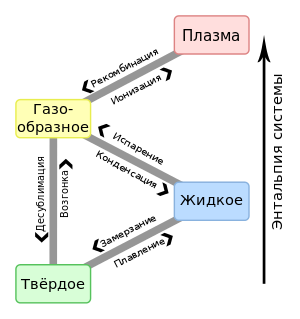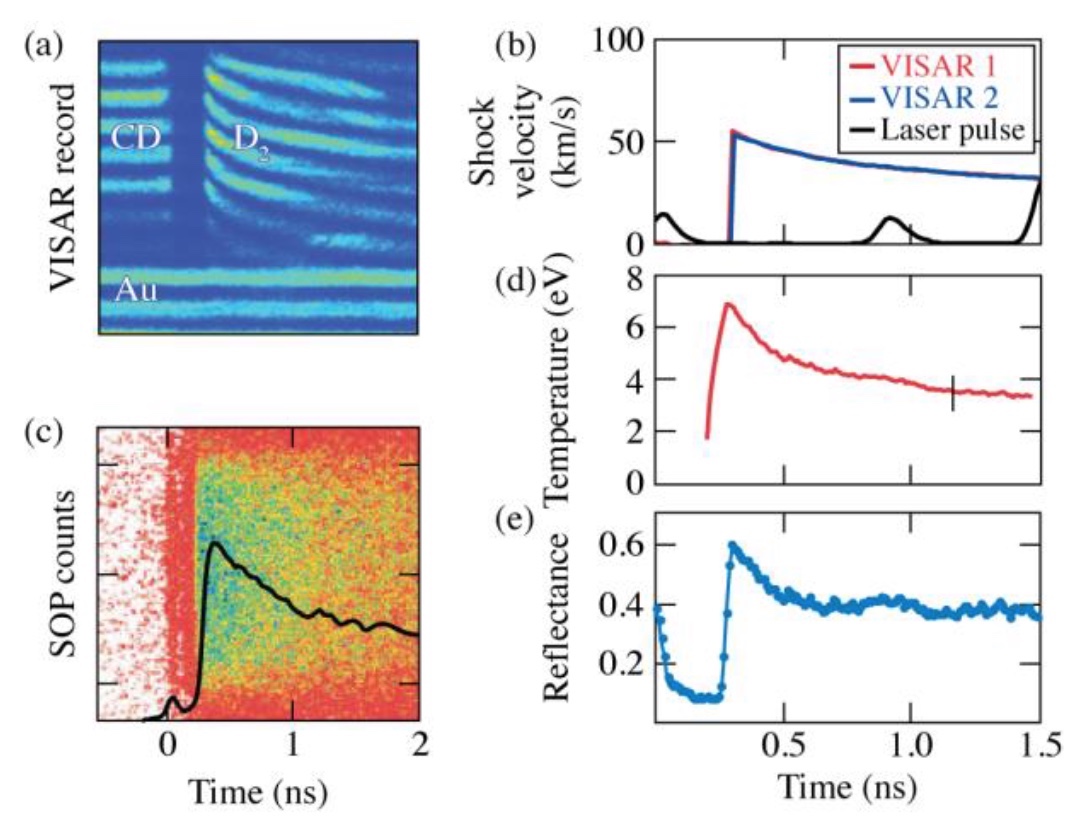Alchemy of the 21st Century: Conversion of Liquid Metallic Deuterium to Plasma

What is common between the stars, lightning and the northern lights? All these “objects” are beautiful in their own way, sometimes they cause the observer to have existential reflections and romantic experiences. However, from the point of view of physics, they have a common feature - plasma. This ionized gas, which is considered the fourth aggregative state of the substance (in addition to solid, liquid and gaseous), is very common in the open spaces of the Universe and is rather massively produced by people. Today, we will look at a study in which scientists were able to convert liquid metallic deuterium into a plasma. What exactly did it take and what results of this "alchemical" experiment? We will look for answers in the report of the research group. Go.
Prehistory
First of all, it is worthwhile to briefly remind yourself that there is plasma and deuterium.
')
Plasma is an ionized gas that is not a substance in a gaseous state. Such is the physical pun. The main elements of the plasma are free electrons and ions. These guys are very mobile, from which the plasma perfectly conducts electric current.
This state was discovered back in 1879 by the English physicist and chemist William Crookes. He believed that in the ionized gas contains the same number of ions and electrons, because the total charge of such a substance will be very small. And this is true - positive and negative particles (on charge) inside the plasma are in complete equilibrium, that is, the charges of the particles compensate each other, with the result that the charge of the internal plasma field is zero. Such neutralization of the charges of each other in particles is called quasineutrality.
Plasma, as I said earlier, is the fourth state of matter, although not all scientists agree with this statement. However, it is worth noting that there are a number of differences from the “ordinary” gaseous state, which give the right to the plasma to be called a separate, fourth state. Among these differences are present: high electrical conductivity, many independent particles (ions, electrons and neutral particles), non-Maxwellian velocity distribution, collective interaction of particles.
Astrophysics, electronics manufacturers and even meteorologists are well acquainted with plasma. Stars, solar wind, outer space, interstellar nebulae are plasma. The lightning bolts, the northern lights, the ionosphere and the lights of St. Elm are plasma. The content of fluorescent neon lamps, plasma rocket engines, monitors and televisions is also a certain type of plasma. In other words, there is not much plasma.
Currently, there are several methods for laboratory plasma production, including: heating a substance, ionization by radiation (ultraviolet, x-ray, laser, etc.), electric charge, ionization by shock waves, etc.
The most frequently mentioned is the thermal method of obtaining plasma, that is, by heating a certain substance to very high temperatures. During this process, certain changes occur in the atoms of a substance — electrons are detached from their orbits, as a result of which free electrons are obtained separately and ions separately.

Plasma can also be produced by passing an electric current through a gas - the gas discharge method. In this case, the ionization of the gas occurs, the degree of which can be changed by manipulating the parameters of the current. However, the resulting plasma, which is actually heated by an electric current, can cool rapidly upon contact with uncharged particles of the surrounding gas.
Plasma in the garage (do not repeat this experience at home, if you do not want an extra visit of doctors and firefighters).
And now a little about deuterium, but not about simple, but about metal.
For a start, what is deuterium? This is heavy hydrogen (D or 2 H), that is, a hydrogen isotope, which has 1 neutron and 1 proton in the nucleus (called deuteron).
The video about how heavy water is obtained from ordinary water - deuterium.
For the first time, deuterium saw the light in 1932 (1931) thanks to the American scientist Harold Urey and Ferdinand Brikvedde, who distilled 5 liters of liquid hydrogen. The result of this procedure was a 1 ml liquid.
But this is a common deuterium; in our study today, we are talking about metallic deuterium. This substance was obtained through exposure to high pressure and high temperatures on deuterium.
In 2015, scientists conducted an experiment to "transform" the insulator into a conductor. Deuterium was chosen as the test subject. Link to download a report on this study.
And now, just a few years later, metallic deuterium became the object of a new study, in which scientists decided to turn it into a plasma.
Research results
During the study, spherical deuterated carbon shells filled with liquid deuterium were used, which were affected by several laser pulses (100 ps, picoseconds). This procedure made it possible to obtain a spherically converging shock wave in the liquid deuterium itself (ρ 0 = 0.172 g / cm 3 ). The laser pulse triggered a pulse drive that produced an initially strong (up to ~ 5.5 Mbar), but not a uniform impact, decreasing in pressure and impact velocity during the propagation process.

Image number 1
VISAR * (velocity interferometer complex for any reflector) and an optical pyrometer * were used to measure impact velocity profiles and self-emission of pulsed impacts inside liquid deuterium.
VISAR * is a time-resolved velocity measurement system using laser interferometry to measure the surface velocity of solids moving at high speed.Image 1A shows the results of VISAR: the vertical axis is a shock divided by time (horizontal axis). From this observation it follows that the damping rate is rather low compared with the equilibration time.
Pyrometer * - a device for contactless measurement of the temperature of bodies.
Optical analysis ( 1C ) was carried out directly above the shock barrier at a depth of 30-40 nm. These numbers were not taken from the ceiling — it is deep enough to monitor the equilibrium state of the plasma, and shallow enough to continuously monitor the changing state of the impact during its attenuation ( 1B ).
The scientists also analyzed the absolute reflection coefficient ( R ), separated from the intensity indicators of the VISAR laser reflected from deuterium during the impact ( 1E ). Temperature data were obtained by measuring the spectral radiation of a shock barrier ( 1D ).
During the tests, scientists observed a shock attenuation from 60 km / h to 35 km / h, which is equivalent to a pressure range of ~ 5.5 ... ~ 0.5 Mbar. Within this range, the density is almost unchanged (ρ = 0.774, TF = 13.8 eV), however, changes in temperature from 3 to 11 eV (1 eV = 11.603 K) are observed. Given the optical properties of deuterium, compressed to 0.774 g / cm 3 , that is, the reflection indices, the scientists were able to verify its electronic properties.
At low pressure, a strong bond and degeneration are observed in the sample (G ≫ 1, ≪ 1). But with increasing temperature, it is these characteristics that change in the first place. Scientists identify two states when these parameters change. In the first at 0.15 <ϴ <0.4 and 2.6 <G <6, a constant optical reflection of about 40% is observed.

Image number 2: the ratio of the reflection coefficient and adhesion.
This value is described by the minimum of the metallic conductivity according to the Mott – Ioffe – Regel rule, when the time for electron – ion relaxation depends on the interatomic distance ( a ) and Fermi velocity (v F ): τ min = a / v F. The Mott – Ioffe – Regel rule predicts that with full ionization the minimum coefficient of optical reflection should be 0.38 with a light emission of 532 nm. Such theoretical conclusions are well compared with practical results of experiments.
The second state occurs when the value of ϴ exceeds 0.4 (T ~ 5 eV). In this case, the reflection grows up to ~ 0.7 at T ~ 11 eV (image No. 2 ). At this moment, the cohesive force decreases when the value of Γ reaches 1. At a temperature of 5 eV, complete ionization of deuterium was expected due to the theoretical dependence of the reflection coefficient and scattering time.
Next, the scientists decided to test the effect of scattering time (τ) on the observed reflectivity. For this, the τ value was determined for the data recorded using the Fresnel formula and the free electron model.

Image number 3
Thanks to the data obtained ( 3B ), scientists have determined that, prior to T / TF ~ 0.4, a Fermi surface will exist in a metallic liquid. But above this temperature index, an increase in the expected relaxation time implies the absence of a limitation in the permissible speed, and to achieve an increase in the reflection coefficient, a longer relaxation time is needed, that is, higher thermal speeds. Therefore, taking into account the relaxation time in the study area, the scientists found that τ ~ T1.55 ± 0.04.
These figures are very close to those of the classical nondegenerate ideal plasma limit (τ ~ T1.5).
Figure 3A shows the results of a comparison of the experimentally derived electrical conductivity with the values predicted by the two transport models in dense plasma. These models are reduced to two opposite limitations: the degenerate Ziman and the non-degenerate Spitzer. However, they do not indicate the exact position of the crossover * .
Crossover * - change in the critical indices of the thermodynamic system with a change in external parameters, during which no changes in the symmetry of the system or jumps in the thermodynamic parameters are observed.This crossover plays a significant role in the thermodynamic and electronic properties of dense conductive liquids. Scientists give the following example: the sign of the chemical potential of the system µ (T) changes from positive in the Fermi – Dirac limit to negative in Maxwell plasma, and the heat capacity C υ goes from C υ ∝ T / T f in the degenerate limit to C υ ~ 3 R.

Image number 4
Finally, scientists compare their creation with similar experiments, but not with deuterium, but with diluted liquid 3 He (helium-3) or with ultracold alkaline gases. In these systems, such a crossover of temperature dependences of the dynamic properties of the atomic fermion system is already related to quantum statistics (image above). Despite the difference of 8–12 times in temperature and density, for all systems, the general rules of degeneracy in Fermi systems remain.
The results of the practical experiment are in excellent agreement with the data of calculations using Monte Carlo methods for dense hydrogen plasma. These calculations showed a significant rearrangement / exchange of electrons in the plasma at T <0.4 TF for different densities. An increase in temperature above this index significantly reduces the probability of quantum exchange between two or more electrons. Since the electron rearrangement / exchange is necessary for the formation of the Fermi surface, as the temperature increases, the electrons no longer degenerate, and the Fermi sphere collapses.
For a more detailed study of the details of the study I strongly recommend to look into the report of the research group .
Epilogue
Scientists are extremely satisfied with their work. This is not surprising, given where their work can be very useful. First, the prediction of the criteria for degeneration in compact astrophysical bodies, which will allow us to determine the boundary between the atmosphere and the degenerating nucleus. Secondly, in the objects of thermonuclear fusion, which will make it possible to accurately determine the desired temperature range in which nuclear fuel must be located during implosion (an explosion directed inward). In addition, scientists believe that their work will help in the study of quantum phenomena in warm dense matter.
The potential is really great, as is the number of questions that scientists have yet to answer during further research on both plasma and such an unusual substance - liquid metallic deuterium.
And, of course, Friday off-top:
"Sweet Home Alabama" (Lynyrd Skynyrd) performed by Tesla transformer.
The arc discharge from Tesla's transformer is one of the illustrative (and very effective) examples of plasma.
"Sweet Home Alabama" (Lynyrd Skynyrd) performed by Tesla transformer.
The arc discharge from Tesla's transformer is one of the illustrative (and very effective) examples of plasma.
Off the top 2.0:
This video does not relate to the research topic (although there is also a liquid metal here), but it would be wrong not to share such beauty :)
This video does not relate to the research topic (although there is also a liquid metal here), but it would be wrong not to share such beauty :)
Thank you for your attention, stay curious and have a great weekend, guys.
Thank you for staying with us. Do you like our articles? Want to see more interesting materials? Support us by placing an order or recommending to friends, 30% discount for Habr users on a unique analogue of the entry-level servers that we invented for you: The whole truth about VPS (KVM) E5-2650 v4 (6 Cores) 10GB DDR4 240GB SSD 1Gbps from $ 20 or how to share the server? (Options are available with RAID1 and RAID10, up to 24 cores and up to 40GB DDR4).
VPS (KVM) E5-2650 v4 (6 Cores) 10GB DDR4 240GB SSD 1Gbps before summer for free if you pay for a period of six months, you can order here .
Dell R730xd 2 times cheaper? Only we have 2 x Intel Dodeca-Core Xeon E5-2650v4 128GB DDR4 6x480GB SSD 1Gbps 100 TV from $ 249 in the Netherlands and the USA! Read about How to build an infrastructure building. class c using servers Dell R730xd E5-2650 v4 worth 9000 euros for a penny?
Source: https://habr.com/ru/post/443692/
All Articles